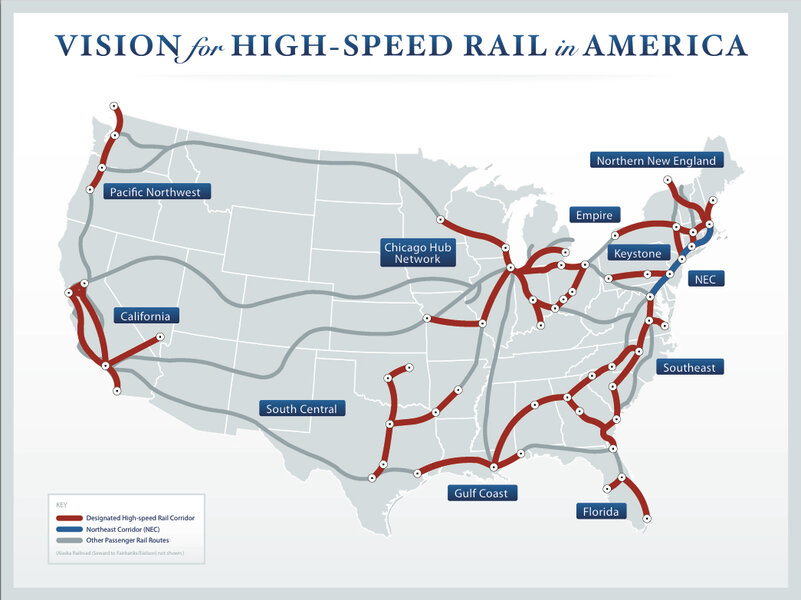On board for fast trains
Loading...
“There’s no reason that Europe or China should have the fastest trains,” said President Obama in his State of the Union speech.
Actually, there is one reason that might hold back America from having a much-needed high-speed rail system: a long-term government commitment to fund it.
True, the Obama White House has worked up a head of steam in favor of fast trains. It has already dedicated $8 billion to them in the 2009 Recovery Act. And it hopes Congress will spend another $5 billion over five years to keep this idea moving.
Together, that would be more than three times the annual budget for Amtrak – a sum as energizing to regular train users as a locomotive whistle.
But the new spending won’t complete even one train line that exceeds 150 m.p.h. – the definition of a fast train. It will help only two states, California and Florida, to build such lines (California’s alone is expected to cost at least $45 billion). And it will improve speed and safety in other corridors around the country, such as St. Louis to Chicago, and Portland, Ore., to Seattle, but not break the 150 m.p.h. barrier there.
If Obama wants to be known for fast trains as Dwight Eisenhower was for interstate highways, he will need long-term buy-in from Congress, from state and local governments, and from private investors. To fund an investment this big, the support must be bipartisan, must include multiple funding sources, and must continue over administrations.
That may not be as hard as it looks, largely because reasons against high-speed rail are falling by the wayside.
One traditional one is that America is too spread out to make fast trains economically viable. But few people are talking about a system to connect the entire country. Over the years, the Department of Transportation has designated 11 “corridors” where high-speed rail would benefit highly populated areas. It’s an approach that makes sense.
Another outdated argument: Americans will never leave their cars. Indeed, the federal highway system, subsidized by the government, helped to weaken a thriving private passenger rail service, which paid taxes. Then came airline deregulation and low airfares.
But serious highway congestion, along with high fuel prices, recently pushed more Americans from their automobiles to mass transit. Add in congested airports, and these conditions bode well for fast trains as a competitive alternative to driving or flying.
The expected travel time on a “bullet” train from San Francisco to Los Angeles, for instance, is about 2-1/2 hours (a driving distance of about 400 miles). Downtown to downtown travel saves time and frustration, and increases productivity. And it saves states from having to pave more highways and build more runways.
Critics also warn of cost overruns and point out that many train systems operate on a regular deficit. True, rail projects around the world bust construction budgets by an average 45 percent – but so can other big infrastructure projects (Boston’s famous “big dig,” for instance). And while other governments do subsidize rail systems, bullet trains themselves are proven moneymakers if designed well.
Democrats and Republicans should hop on the fast-train idea. As a national security measure, a speedy train network will help wean America from foreign oil. It offers a transportation choice that’s efficient, relatively environmentally clean, and comfortable. It will lead to business development around stations and destination points. And many jobs that will come with it – track laying, maintenance, and operation – can’t be outsourced.
Obama’s plan won’t bring fast trains to the United States anytime soon. But it starts America on the track to a new and efficient kind of transport. Remember that it wasn’t until 1992 that the last piece of the originally planned interstate highway system was finished – a plan that Congress first approved in 1956. Americans are glad they have it, and they’ll feel the same when fast trains finally become a reality.





